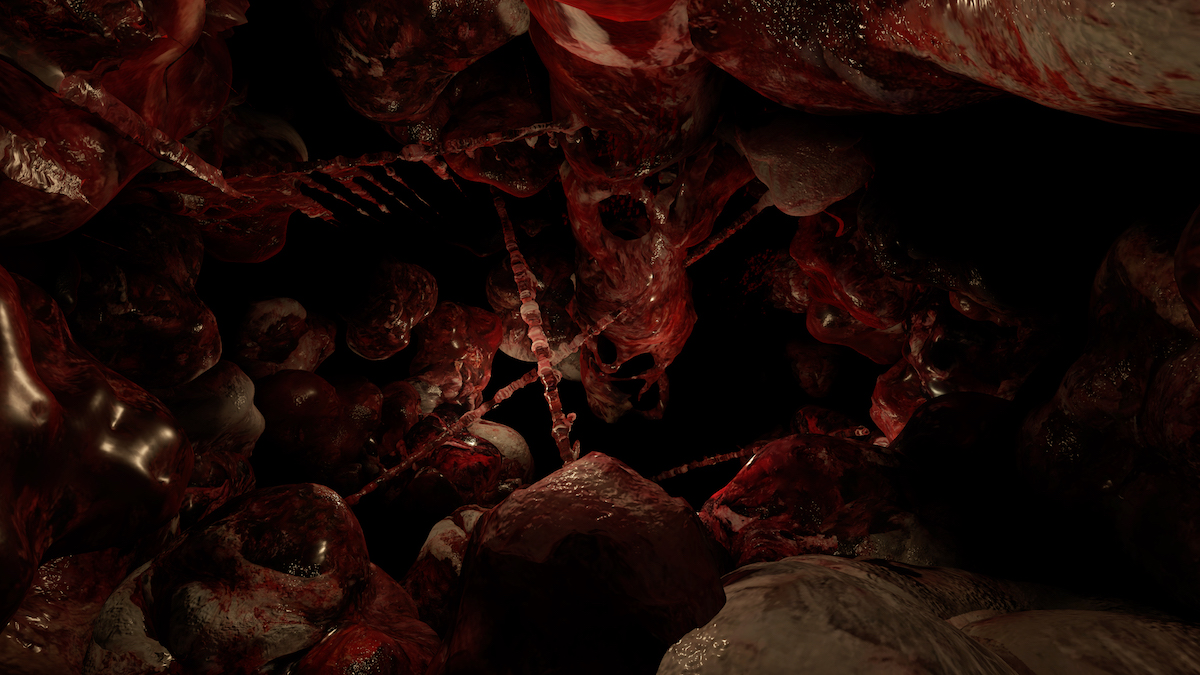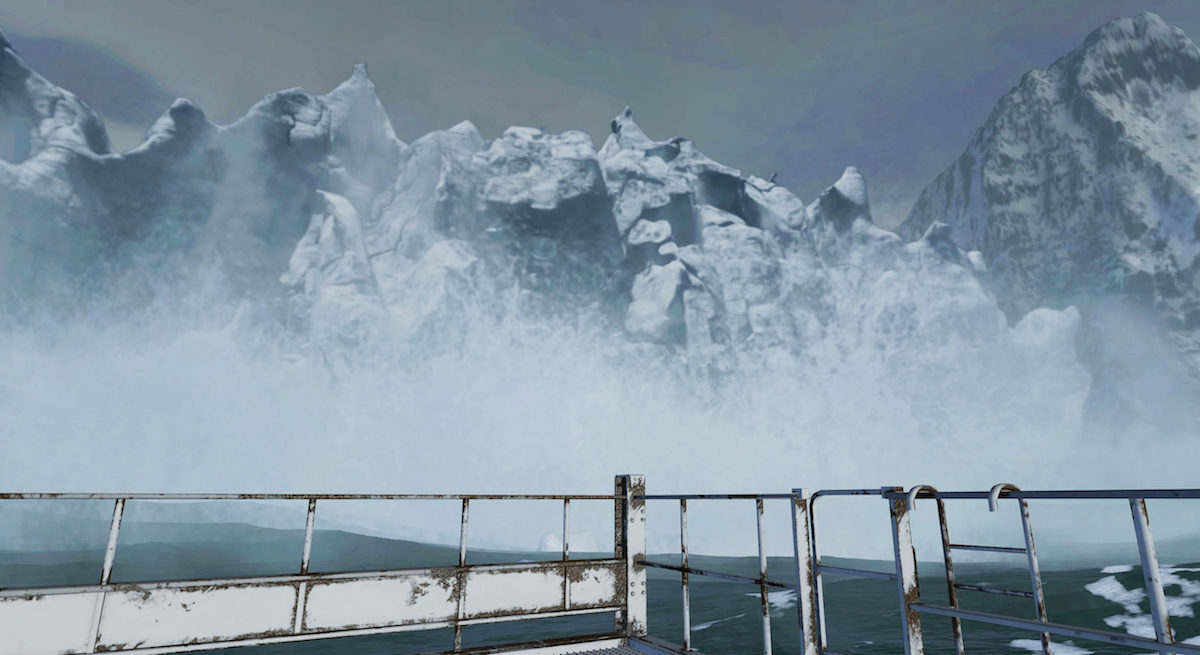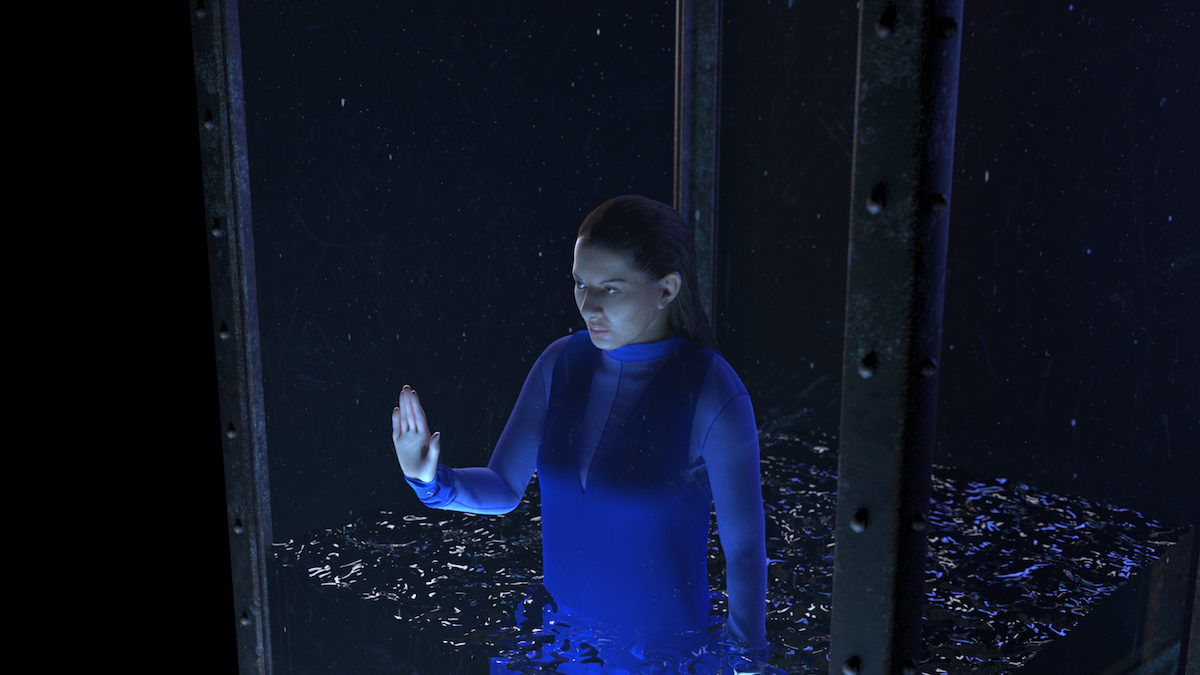
It’s like stepping inside a sketchbook. Everywhere I look—up, down, left, right—there’s only white. No distances, no dimensions, just empty space; a blank page until black scribbles start scratching 3D shapes all around me. A world draws itself into existence.
Thick brushstrokes build into a tree, its canopy blooming overhead like calligraphy. Hand-drawn flowers form at my feet. Criss-crossing lines race into crazy paving and the outline of a house, a childish cartoon rises up in front of me: box-windows, brick walls, a front door. When I reach for the scribbled handle I find, with both delight and a little disbelief, that it’s solid—metal, hard, cold to the touch. When I step inside, my feet squish into carpet as a sitting room sketches itself out in space.
“With VR, the final edit’s in the audience’s control. They can look where they want to, and theatremakers are already trained to anticipate that”
This is the start of Draw Me Close—a short virtual reality performance that turns animation into architecture. Created by the National Theatre and the National Film Board of Canada, it brings Teva Harrison’s illustrations to life. You open a black and white window, sit down on a sketched bed, reach out and hug an animated figure—a woman, a mother—who addresses you as if she were in the room with you.
She is. Actress Tamzin Griffen wears a motion capture suit that tracks her movements and translates her into cartoon form. She interacts with individual audience members wearing heavy VR goggles, playing writer-director Jordan Tannahill’s mother as they navigate his childhood home—or a cartoon of it. The reality is a square of carpet, sparsely furnished, with a window frame and a fake door in a black box studio at the Young Vic. It is a dislocating experience.

Virtual reality feels like an artistic frontier—still. The term itself was conceived in the mid-eighties, but the idea of it—the ambition—dates back to decades before that. In 1956, film engineer Morton Heilig’s Sensorama exhibit sought to situate audiences “inside” a movie, simulating a motorcycle ride through a city by combining POV footage with experiential sensations: the vibrations of an engine, the smell of an exhaust. Heilig later turned to head-mounted hardware, hoping to fully envelop the viewer in what we’d now call a virtual sphere.
Sixty years on, there’s something of an artistic gold rush going on. VR still seems futuristic, but all sorts of artists are toying with the form. Different disciplines are staking their particular claim. Visual artists create walkthrough images and unreal sculptures—Marina Abramovic and Anish Kapoor both created epic projects for last year’s Art Basel in Hong Kong. Filmmakers point to the primacy of the screen. Game-designers cite graphic design.
Theatre is stressing its credentials too. The Royal Shakespeare Company has partnered with Fortnite creator Epic Games to make a large-scale VR piece by 2020. The National Theatre launched an Immersive Storytelling Studio three years ago, exploring the possibilities of 360 film and virtural reality. “The practice is much closer to making theatre than it is making film,” says studio head Toby Coffey. VR is a hybrid art form. “It works best as part of an ecosystem.”

Virtural reality is, at root, a trick of the mind. While film sits viewers in front of an image, VR—like theatre—creates an illusion reliant on our suspension of disbelief. Both forms layer fictional spaces onto real ones, so audiences buy the setting over the stage. The trick is to cement that investment. In Draw Me Close, the basic physical set sells the fictional setting, even as the abstracted animation allows us to activate our own imagination. Instead of seeing an actor—a stranger—identifying as our mother, we’re able to project onto the blank space of an avatar, theoretically allowing us into Tannahill’s personal memory.
As an art-form, it’s embodied, spatial, experiential—more theatrical than filmic. Crucially, for Coffey, it affords audiences agency. “Films present a beautifully crafted rectangle, edited in post-production,” the former television producer explains. “With VR, the final edit’s in the audience’s control. They can look where they want to, and theatremakers are already trained to anticipate that.”
“My feet squish into carpet as a sitting room sketches itself out in space”
The two things combine to make an all-encompassing experience. Put the headset on and, to a surprising extent, you leave your actual surroundings behind. It’s as if all your senses switch channels, reorientate, surrending to your new apparent environment. You’re conscious of real space in Draw Me Close, but more as an idea than a impression. If there’s a snag of scepticism, it’s conceptual rather than perceptual—a refusal to give in completely, to forget oneself and one’s actual situation.
- Marina Abramović, still from Rising, 2017, courtesy of Acute Art
This, says Coffey, is VR’s particular strength. It is transportative, but before that it’s meditative. To get somewhere else, you must first depart, and VR’s excellent at establishing the foundations for escapism. If we go with it, it can whisk us away. Coffey likens wearing goggles to closing one’s eyes; a waking dream. “The psychology of that is a much stronger connection,” he explains.
It’s true. Draw Me Close unfurls Tannahill’s childhood memories, his relationship with his late mother. The awkwardness of playing with her, like a child, gives way when her avatar sits me down at a table to explain that she has terminal cancer. A flicker of empathy, even identification, crackles across my skin. I see—no, sense—myself in the same situation; my mother sitting me down to say the same thing. There’s a flush of feeling. I shiver.

Virtual reality is still rudimentary. The clumsiness of Draw Me Close obstructs the overall—avatars that aren’t quite in the right place, wires that weigh down on your shoulder—and the medium’s constraints can only carry a simple story at present. It does point to potential, an art-form of its own, and Coffey’s clear that form has to marry content. It does here, not only by providing an experience of something over an illustration or a narration of it, but by entwining ideas of art, erasure and memory. It draws a world and invites us inside and, like all things in life, allows it to disappear. It’s less like a sketchbook then, more like an etch-a-sketch, and like all theatre, it’s transitory.







